Paulinus was a Roman missionary and the first Bishop of York. A member of the Gregorian mission sent in 601 by Pope Gregory I to Christianize the Anglo-Saxons from their native Anglo-Saxon paganism, Paulinus arrived in England by 604 with the second missionary group. Little is known of Paulinus's activities in the following two decades.
Macrina the Elder was the mother of Basil the Elder, and the grandmother of Basil the Great, Gregory of Nyssa, Peter of Sebaste, and Macrina the Younger.
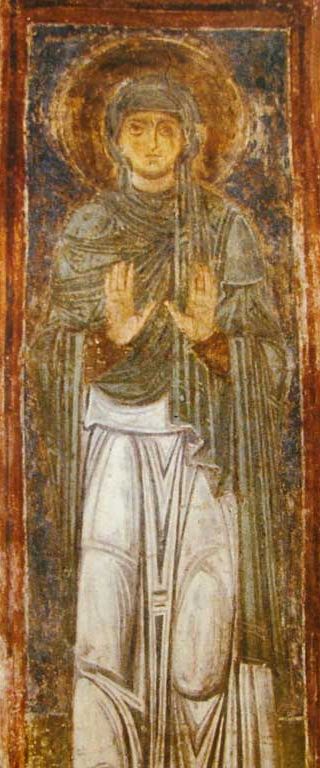
Macrina the Younger was an early Christian consecrated virgin. She is regarded as a saint in the Roman Catholic, Eastern Orthodox, and Anglican churches. Macrina was elder sister of Basil the Great, Gregory of Nyssa, Naucratius and Peter of Sebaste. Gregory of Nyssa wrote a work entitled Life of Macrina in which he describes her sanctity and asceticism throughout her life. Macrina lived a chaste and humble life, devoting her time to prayer and the spiritual education of her younger brother Peter.
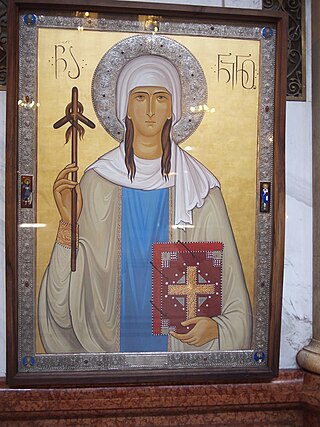
Saint NinoEqual to the Apostles and the Enlightener of Georgia was a woman who preached Christianity in the territory of Caucasian Iberia, of what is now part of Georgia. It resulted in the Christianization of the royal house of Iberia, with the consequent Christianization of Iberia.
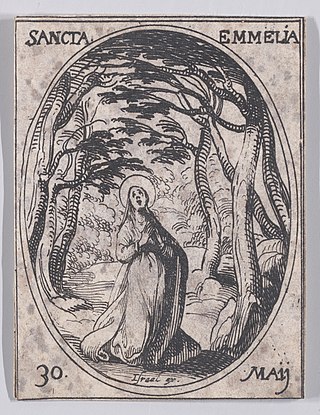
Emmelia of Caesarea was born in Cappadocia, a province of the Roman Empire. She died on 30 May 375 AD. She was born in the late third to early fourth century, a period in time when Christianity was becoming more widespread, posing a challenge to the Roman government and its pagan rule. She was the wife of Basil the Elder and bore nine or ten children, including Basil of Caesarea, Macrina the Younger, Peter of Sebaste, Gregory of Nyssa, and Naucratius.

Dorcas, or Tabitha, was an early disciple of Jesus mentioned in the Acts of the Apostles. She lived in the port city of Joppa, today absorbed by Tel Aviv. Acts describes her as being known for her "good works and acts of mercy", sewing clothes for the poor. When she died, the widows of her community mourned her and sent urgently for Peter, who was in nearby Lydda. As evidence of her charity, they showed him some of the clothes she had sewn, and according to the biblical account he raised her from the dead.
Saint Edburga of Minster-in-Thanet was a princess of Wessex, and abbess of Minster-in-Thanet. She is regarded as a saint.

Saints Marcellinus and Peter are venerated within the Catholic Church as martyrs who were beheaded. Hagiographies place them in 4th century Rome. They are generally represented as men in middle age, with tonsures and palms of martyrdom; sometimes they hold a crown each.
Peregrine (Peregrinus) of Auxerre is venerated as the first bishop of Auxerre and the builder of its first cathedral. A strong local tradition states that he was a priest of Rome appointed by Pope Sixtus II to evangelize this area at the request of the Christians resident in that part of Gaul. He preached at Marseilles, Lyon, and converted most of the inhabitants of Auxerre to Christianity.

Aspren or Asprenas was a 1st-century Christian saint and venerated as the first Bishop of Naples.
Anastasius of Pavia was Bishop of Pavia (Ticinum) from 668 until his death in 680. He was a convert from Arianism. He was succeeded by Damian of Pavia.

The woman with seven sons was a Jewish martyr described in 2 Maccabees 7 and other sources, who had seven sons that were arrested by Antiochus IV Epiphanes, who forced them to prove their respect to him by consuming pork. When they refused, he tortured and killed the sons one by one in front of the unflinching and stout-hearted mother.
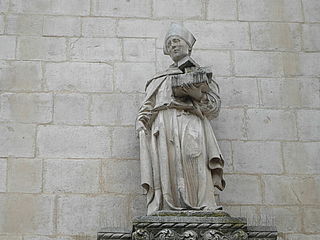
Pamphilus of Sulmona was bishop of Sulmona and Corfinio (Valva) during the late 7th century. He is revered as a saint by the Roman Catholic Church and the Eastern Orthodox Church.

The Basilica of San Pietro ad Aram is a Baroque-style, Roman Catholic church in Naples, Italy. It is located about a block from the church of the Santissima Annunziata on Corso Umberto I.

Saint Claudia may refer to:

Candida Xu or Candida Su, was a Chinese Catholic who lived in late Ming and early Qing China. She has been called "arguably the most influential Chinese Christian woman of the seventeenth century." She is also, according to records, likely the first Chinese woman who knows Latin.
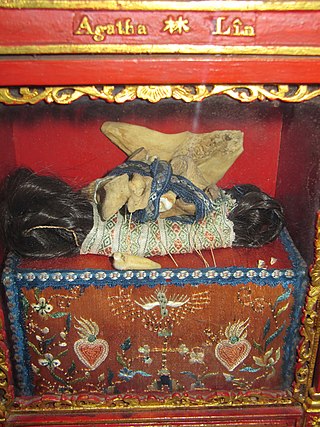
Agatha Lin, born in Qinglong in the Guizhou of southeast China in 1817, was a Chinese saint and martyr. She was a headmistress and catechist, and one of the first to evangelize the Miao people. She was beheaded for her faith on January 28, 1858. Agatha was beatified by Pope Pius X on May 2, 1909, and canonized in 2000. Her feast day is February 18.
Apollinaris Syncletica was a saint and hermit of the 5th century, venerated in the Roman Catholic and Eastern Orthodox churches. Her story is most likely apocryphal and "turns on the familiar theme of a girl putting on male attire and living for many years undiscovered".

Grata of Bergamo is an Italian saint and martyr, and sister of Asteria of Bergamo. Her parents were Saint Lupo of Bergamo and Saint Adelaide, duke and duchess of Bergamo. According to hagiographer Agnes B.C. Dunbar, Grata's husband was "a great king in Germany". She did not become a Christian until after his death, when she converted her parents to Christianity and persuaded them to build the cathedral of Bergamo. She became known as a holy woman in Bergamo, "especially for her zeal in securing Christian burial for the bodies of martyrs". She built three churches and a hospital for the poor in Begamo. She and her sister Asteria buried the body of St. Alexander of Rome, after Grata wrapped his head in a napkin. After her parents' death, she governed Bergamo "with wisdom and benevolence". Grata was put to death for burying Alexander. Her feast day is September 4.

Saint Paulina was a Roman martyr. Her feast day is celebrated on June 6.













